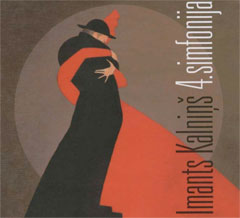
Perhaps the most well known of Latvian symphonic works, and certainly one of the most popular, is “Symphony No. 4” by composer Imants Kalniņš. It is a composition that has been nicknamed by some as the “Rock” symphony, as it combines classical motifs with elements of rock to form a groundbreaking work.
The recording company Upe tuviem un tāliem last year released both compact disc and LP versions of the symphony performed by the Liepāja Symphony Orchestra conducted by Imants Resnis.
Originally composed in 1973, “Symphony No. 4” was an immediate hit. However, at the time Soviet authorities forbade the performance of the symphony’s fourth movement (which features a soprano solo, the text of which is made up of selections from the poetry of American poet Kelly Cherry, which in turn quotes from poetry by Robert Browning). The original movement was only allowed to be restored much later.
Though there have been multiple recordings of the symphony (particularly notable is the 1998 release by MICREC, which featured a live performance by the Liepāja orchestra), this new release is the first studio recording to include the original fourth movement.
The elements of classical and rock can be immediately heard in the first movement of the work, with its driving beat and its sense of tension rising as the movement progresses, reaching a thunderous climax. The performance features the percussion performance of distinguished rock drummer Vilnis Krieviņš (who has played with a number of groups, most notably Līvi). Though the climax arrives early in the movement, the tension and drive is relentless, with the percussion providing the rhythmic foundation.
The second movement, in a rather abrupt change from the first, is musically far more relaxed and tender. Here one can hear more “Latvian” elements, giving some of the melodies an almost folk song-like quality.
The fourth and final movement, the one that caused the Soviet authorities grief in the early 1970s, is also a departure from the previous movements. The solo (on this recording, performed by mezzosoprano Ieva Parša) is brought forward as the orchestra stays in the background for most of the movement. The angst-filled poetry of Cherry returns the tension of the first movement, and Parša deftly adapts to the emotional changes necessary, as the words rapidly move between love, anger and sorrow.
I am extremely reluctant to even mention this, but, unfortunately, there are a few spots where the English diction is not as good as it could be. Though Parša is certainly one of the leading Latvian mezzosopranos (listen to her solo CD, Skaņu labirints, which feature modern vocal works by Latvian composers), there are a handful of spots where it is difficult to determine what she is singing. With the words—and, correspondingly, feelings and emotions—being so important in the fourth movement, diction is critical.
To be very honest, I slightly prefer the original 1998 recording of the work. Perhaps, since it was a live recording, there was a higher sense of tension in the recording, which adds to the dramatic effect of the symphony, particularly in the first movement. Additionally on that release, the solo vocal in the fourth movement was performed by American soprano Patti Cohenour, who is better able to express the nuances of the text than someone whose native language is not English.
The CD packaging includes the poetic text by Cherry, along with Latvian translation. It would have been helpful to have a bit of background of the work itself, perhaps commentary from the composer himself, if not some musicologists, as to what made this work so significant and beloved at the same time.
Make no mistake, this recording is highly enjoyable, reminding the listener of why this symphony is one of the key works in Latvian classical music. Though the symphony is almost 40 years old, it still sounds as vital as ever, and its dramatic effect is still as gripping as when it was first performed.
Details
4. simfonija
Imants Kalniņš
Upe tuviem un tāliem, 2009
Upe TT CD046
Track listing:
Allegretto
Andante trnquillo
Grave molto
Moderato rubato
Where to buy
Purchase 4. simfonija from BalticShop.
Note: Latvians Online receives a commission on purchases.
© 1995-2024 Latvians Online
Please contact us for editorial queries, or for permission to republish material. Disclaimer: The content of Web sites to which Latvians Online provides links does not necessarily reflect the opinion of Latvians Online, its staff or its sponsors.





Thanks for the news about Kalnins’ 4th symphony. I have 2 recordings of this work, but I would like to buy the abovementioned recording too. Unfortunately the Baltic Shop knows nothing about this CD! – when I try to find it there. Can you help me? Do you know another place where I can find it? I hope you can help me!